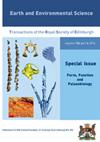Landscape response to deformation in the Sabalan area, NW Iran: Inferred from quantitative morphological and structural analysis
IF 1.2
4区 地球科学
Q4 GEOSCIENCES, MULTIDISCIPLINARY
Earth and Environmental Science Transactions of the Royal Society of Edinburgh
Pub Date : 2022-08-31
DOI:10.1017/S1755691022000135
引用次数: 2
Abstract
ABSTRACT The geological and tectonic background of the Sabalan area in NW Iran and its present-day surface processes make it ideal for examining the effects of tectonic processes in shaping the Earth's crust. As a result of the intense distribution of pre-Quaternary and Quaternary structures (e.g., faults, joints and folds), most of the drainage basins in the southern and central parts of the study area have developed under tectonic-dominated conditions, whereas the effects of erosional processes are greater in the north and east. An evaluation of the geomorphic indices using the index of active tectonics (IAT) and analytical hierarchy process (AHP) methods shows that the AHP results are more reliable than the IAT results and are coherent with the geological and structural conditions of the study area. The geomorphic results are highly consistent with the intensity and distribution of fractures. The majority of fractures have developed in a NW–SE direction, indicating antithetic R′ Riedel fractures to the main NE-SW-trending faults. However, a significant number of the fractures in the study area are NNE–SSW- and NE–SW-oriented R and P fractures and NNW–SSE-oriented tension fractures. Palaeostress analysis of the fault data shows at least two faulting events in the pre-Quaternary and Quaternary, respectively. The pre-Quaternary NNW–SSE-striking dextral strike-slip faults experienced post-Eocene 25–30° clockwise rotation and re-activated as NE–SW-striking sinistral faults during the Quaternary. Although seismic activity is currently low, the consistency of our results with the regional stress data show that the study area is still tectonically active.伊朗西北部萨巴兰地区景观对变形的响应:从定量形态和结构分析推断
伊朗西北部萨巴兰地区的地质和构造背景及其现今的地表过程使其成为研究构造过程对地壳形成影响的理想场所。由于断裂、节理和褶皱等前第四纪和第四纪构造的强烈分布,研究区南部和中部大部分流域是在构造主导条件下发育的,而北部和东部受侵蚀作用的影响较大。利用活动构造指数(IAT)和层次分析法(AHP)对研究区地貌指标进行评价,结果表明,层次分析法的评价结果比活动构造指数的评价结果更可靠,且与研究区地质构造条件相吻合。地貌结果与裂缝的强度和分布高度一致。裂缝以NW-SE向发育为主,与ne - sw向断裂形成反R′Riedel断裂。然而,研究区内大量裂缝为NNE-SSW和ne - sw向的R和P裂缝以及nnw - se向的张性裂缝。对断裂资料的古应力分析表明,前第四纪和第四纪至少发生过两次断裂事件。第四纪前nnw - se向右走滑断裂在始新世后经历了25-30°顺时针旋转,并在第四纪重新激活为ne - sw向的左旋断裂。虽然目前地震活动较低,但我们的结果与区域应力数据的一致性表明,研究区仍有构造活动。
本文章由计算机程序翻译,如有差异,请以英文原文为准。
求助全文
约1分钟内获得全文
求助全文
来源期刊
CiteScore
2.00
自引率
0.00%
发文量
21
期刊介绍:
Earth and Environmental Science Transactions (formerly Transactions of the Royal Society of Edinburgh: Earth Sciences) is a general earth sciences journal publishing a comprehensive selection of substantial peer-reviewed research papers, reviews and short communications of international standard across the broad spectrum of the Earth and its surface environments. The journal prides itself on the quality of its graphics and photographic reproduction. The Editors are keen to encourage interdisciplinary papers and Transactions also publishes occasional special symposia and invited volumes of specific interest.
We are currently in the process of digitising the archive of RSE Publications, and the archive of the Transactions, dating back to 1788, will be available from the back issues link on this site.

 求助内容:
求助内容: 应助结果提醒方式:
应助结果提醒方式:


